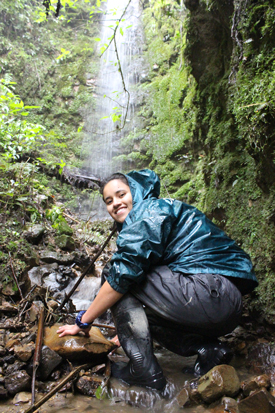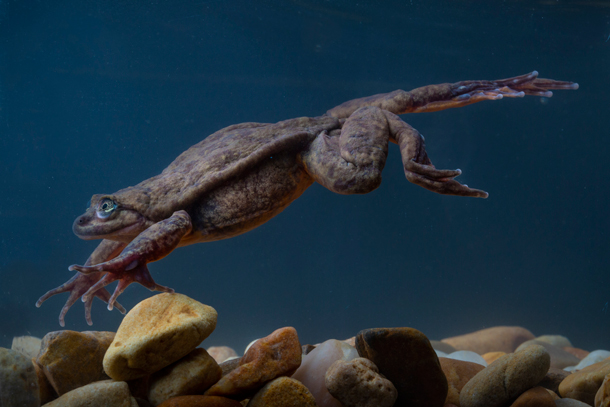‘Romeo and Juliet’ Frogs’ First Steamy Date
Air Date: Week of August 23, 2019

Romeo and Juliet. This match gives hope to a species that was on the brink of extinction due to destruction of its habitat and the deadly disease chytrid fungus. (Photo: Courtesy of the K’ayra Center for Research)
Sehuencas water frogs, like other amphibians, have been devastated by the chytrid fungus, and a frog that scientists named “Romeo” was the last known of his kind and had stopped singing for a mate. But recently scientists discovered “Juliet” and four other Sehuencas water frogs hiding in the Bolivian cloud forest – and Romeo’s song is back. Sofia Barrón Lavayen, the manager of captive breeding at the K'ayra Center at the Museum of Natural History in Cochabamba, Bolivia, talks with Living on Earth’s Aynsley O’Neill about how the matchmaking is coming along.
Transcript
CURWOOD: It’s Living on Earth, I’m Steve Curwood.
The deadly chytrid fungus is responsible for dramatic declines in more than 500 species of frogs and other amphibians, according to recent study published in Science. And as many as 20% of those amphibians now are assumed to be extinct. Until recently, sehuencas water frogs were among those on the brink of extinction. Just one male, named Romeo, was living in a lab in Bolivia, assumed to be the last of his species. But researchers recently found 5 more of these frogs in a cloud forest in the mountains of Bolivia. They took one of the females, named her Juliet, and brought her to meet Romeo. Hoping they won’t be star-crossed lovers, the researchers are now breeding Romeo and Juliet in an attempt to save the species. Sofia Barrón Lavayen is the head of conservation breeding for the K’ayra Center at the natural history museum in Cochabamba, Bolivia. She spoke with Living on Earth’s Aynsley O’Neill about how the matchmaking is coming along.
O’NEIL: Tell us a little bit of the backstory. How did Romeo and Juliet meet?
Barrón: First Romeo was in center Kayra since 2009. So that means ten years he was alone and we thought it was the last species. So we create this project to go to look for a mate. That's how we found Juliet on December 2018. And that's how they are together now.
O’NEIL: And so they had their first date. How do you set up the first date for a frog? Is their mood music, are there low lights?
Barrón: Yeah, first it's really important for our for amphibians that the water quality has to be perfect all the parameters has to be perfect for the species. Why? Because exactly this species sehuencas water frog is an aquatic frog. So they breed in exchange all the ions through the skin so that's why the water is so important so first we need to check that the water has to be perfect and then the temperature as well and then it's really interesting because all amphibians around the world they reproduce they know that it's breeding season because of the rain. So we install like a rain system in the water that helps to helps to realize for the frogs to being the breeding season so first we did all these things we prepare and then we put it together. The day was really amazing for me was super excited all the team was really excited because when we put Romeo together with Juliet, we record the first call so Romeo called for the first time with a mate. The last call we record it was in 2017, so two years ago, but now we register the this call. They are looking for a mate. So it's the courtship call. It was really amazing. It's super loud and it's the first record for this species.

Sofia Barrón Lavayen during the expedition when Juliet was discovered, along with four other Sehuencan water frogs. (Photo: Courtesy of the K’ayra Center for Research)
O’NEIL: I'm glad to hear that the date was going well. And since the first-time Romeo has been with another of his species in such a long time in 10 years, how was he acting on the date? Was he romantic? Was he nervous?
Barrón: Yeah he looked a little bit nervous. In the beginning but then he looked at Juliet and he swam directly to her to do the Amplexus, Amplexus is the mating embrace position for frogs, he swam really fast into her and he started doing also a really funny dance we call the twinkly toes. He moved his toes, like on the dance like he was shaking his toes. While he was in amplexus. So that was also something new for us. So he was a little bit shy and then he directly went with Juliet so he was super happy and Juliet as well.
O’NEIL: What is your favorite part about taking care of these frogs?
Barrón: For me it's really funny to give them food because their behavior it's really fascinating. The frogs catch the worms with their front legs, making a forward movement and sometimes the worms escape or the frogs cannot catch it's like a little bit silly for me because they don't catch it immediately super funny to watch. But when Romeo was alone in the aquarium he ate immediately the worm of the isotope but now since Juliet is with him. He leaves the worms and the isotopes for her it's really interesting. That's also new for us. We never seen it before. So it's something interesting.
O’NEIL: And how of Romeo and Juliet been in the days after their first date?
Barrón: Well, they were trying amplexus. A lot of times the longest amplexus was 15 minutes. I hope they are gonna lay eggs soon. I'm really excited to see the eggs because we don't know how many eggs they put. We don't know where they put it, where they lay the eggs under the rocks or between rocks or just in the surface of the aquarium. We don't know it's something new for us. We are also really excited to see.
O’NEIL: What would happen if Romeo and Juliet don't get along romantically?

Juliet has proven to be healthy and outgoing. Researchers are hopeful that she and Romeo will be able to reproduce. (Photo: Robyn Moore, Global Wildlife Conservation)
Barrón: Oh, we have a lot of options. Juliet and Romeo are not the only individuals of these species. We have four more individuals that means to more couples. So our option B is to try with the other couples mix Romeo with other frog with the other two females or the other male mix with Juliet and yeah, we have a lot of options and Yeah, I'm really happy for the conservation of this species I'm pretty sure they are going to reproduce.
O’NEIL: Sophia, thank you so much for taking the time.
Barrón: Oh, thank you everybody and keep in touch for the news from Romeo and Juliet.
CURWOOD: Sofia Barrón Lavayen spoke with Living on Earth’s Aynsley O”Neill. We recently checked with the researches and the good news is the frog couple is happily living together though so far no polliwogs.
Links
Museo de Historia Natural Alcide d’Orbigny | “Romeo & Julieta - (La Primera Cita)”
Global Wildlife Conservation | "A Q&A With Romeo & Juliet’s Personal Assistant"
Global Wildlife Conservation | "#Match4Romeo"
National Geographic | "Meet Romeo, 'world’s loneliest frog,' and his new mate Juliet"
New York Times | "Romeo, Meet Juliet. Now Go Save Your Species."
Living on Earth wants to hear from you!
Living on Earth
62 Calef Highway, Suite 212
Lee, NH 03861
Telephone: 617-287-4121
E-mail: comments@loe.org
Newsletter [Click here]
Donate to Living on Earth!
Living on Earth is an independent media program and relies entirely on contributions from listeners and institutions supporting public service. Please donate now to preserve an independent environmental voice.
NewsletterLiving on Earth offers a weekly delivery of the show's rundown to your mailbox. Sign up for our newsletter today!
 Sailors For The Sea: Be the change you want to sea.
Sailors For The Sea: Be the change you want to sea.
 The Grantham Foundation for the Protection of the Environment: Committed to protecting and improving the health of the global environment.
The Grantham Foundation for the Protection of the Environment: Committed to protecting and improving the health of the global environment.
 Contribute to Living on Earth and receive, as our gift to you, an archival print of one of Mark Seth Lender's extraordinary wildlife photographs. Follow the link to see Mark's current collection of photographs.
Contribute to Living on Earth and receive, as our gift to you, an archival print of one of Mark Seth Lender's extraordinary wildlife photographs. Follow the link to see Mark's current collection of photographs.
 Buy a signed copy of Mark Seth Lender's book Smeagull the Seagull & support Living on Earth
Buy a signed copy of Mark Seth Lender's book Smeagull the Seagull & support Living on Earth

